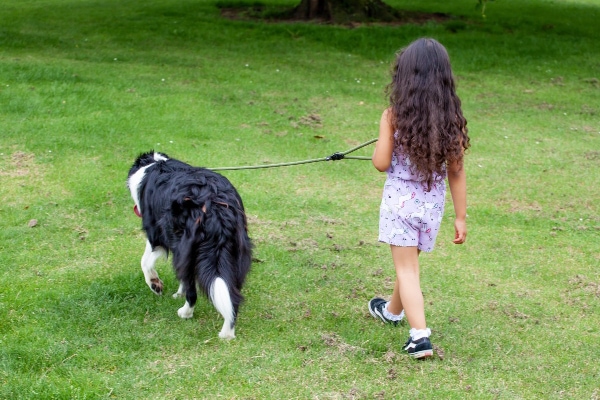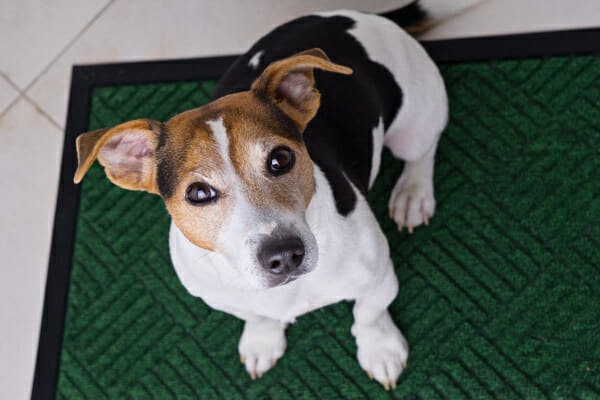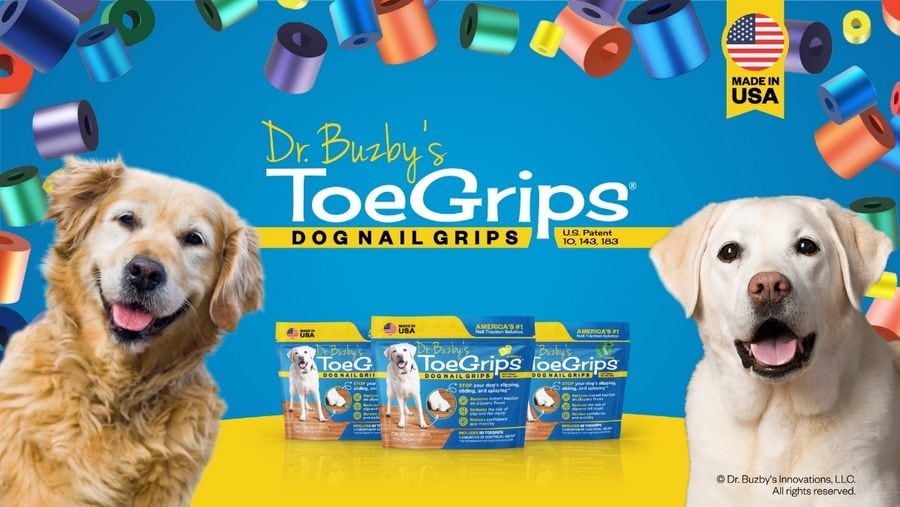The term “proprioception” in dogs (i.e. the ability to tell where the limbs are in space) may not mean much to you until your dog starts walking oddly. Suddenly it seems proprioception is a major health factor. Integrative veterinarian Dr. Julie Buzby explains what proprioception is, how we evaluate it, reasons for proprioception loss, and ways to help your dog.

Conscious proprioception in dogs is a sign of a functional nerve connection between their paws and their brains. We don’t tend to think about it until we run into problems. Proprioceptive deficits in dogs can affect gait, balance, and coordination. It is important to understand how proprioception ties into dogs’ nervous system health.
When a dog’s walking seems “off”
Some dog breeds have special characteristics I hold dear. For Corgis, it’s their cute and fluffy backsides. The subject of tons of viral videos online, the ridiculously adorable “sashay” walk they do is so distinctive. I’m convinced that, as a breed, they have the most charismatic butt of any dog.
Weird as it may sound, this gait is what brought Maisie in to see me one day. Her waggle was off. At first, her mom assumed it was a one-off. Maybe Maisie had slipped on something or her foot had fallen asleep during her afternoon nap. But as the days went on, she noticed a more consistent gait abnormality and decided to bring her in for a physical exam.
I asked my assistant to walk our patient up and down the hallway, and I could see her sort of dragging her right hind foot along the ground as she brought it forward. She had a normal range of motion, and didn’t seem painful anywhere in her leg.
However, when we got to her neurologic exam, I could tell something was wrong. This carefree Corgi had signs of proprioception loss in her right hind leg.
What is proprioception in dogs?
In simple terms, proprioception refers to whether a dog’s brain knows where their limbs are in space. A neurologic connection between the paws and the brain allows a dog to stand and walk normally.
When everything is working right, sensory nerves in the paw send signals about leg position up the leg, through the spinal cord, to the brain. The brain then sends signals back to the nerves in the leg and paw to bear weight and move appropriately.

In dogs with proprioceptive deficits, this connection is interrupted.
How do you test for proprioceptive deficits in dogs?
To initially test proprioception, the vet typically will turn the paws over, one at a time, so they are knuckle-side down on the floor or exam table. A normal, healthy dog will right the paw pretty much immediately.
A dog that either has a delay in turning the paw back over, or one that leaves the paw in the incorrect position has proprioceptive deficits. This is an indication of a neurologic issue.
The video below demonstrates how to test proprioception. You can see that as soon as we place the dorsal surface (i.e. top part) of the dog’s paw on the floor, she corrects it immediately.
What causes proprioception loss in dogs?
There are a number of conditions that can affect dogs’ proprioception. Some of these include:
- Trauma—This can range from pinching a nerve jumping off the couch wrong to being hit by a car.
- IVDD in dogs (i.e. intervertebral disc disease)—Sometimes one or more of the discs that normally lie between the vertebra (i.e. intervertebral discs) bulge or rupture into the spinal canal. This causes spinal cord compression and decreased or lost proprioception.
- Degenerative myelopathy in dogs—Possessing two copies of the mutated gene SOD-1 seems to predispose dogs to this progressive and irreversible spinal cord degeneration, which is similar to Lou Gehrig’s Disease or ALS in humans.
- Spinal stoke in dogs—Occasionally a piece of an intervertebral disc will break off, lodge in a blood vessel, and cut off blood supply to a portion of the spinal cord. Without blood supply, the spinal cord can’t function correctly.
- Wobbler’s disease—In this condition, the spinal cord becomes compressed as it runs through the neck. Typically, the spinal canal in these dogs is more narrow than normal because of bony changes or intervertebral disc herniation.
- Miscellaneous neurological conditions—Tumors, inflammatory or infectious conditions, and other neurologic diseases can also affect the nervous system’s ability to transmit proprioceptive signals.
Could deficits in proprioception in dogs be caused by anesthesia?
I have occasionally been asked whether a dog can develop proprioceptive issues after an anesthetic procedure. In general, my answer is no. It is theoretically possible that a nerve block or epidural used during some surgeries may take longer than expected to wear off.
But general anesthesia is not known to cause permanent proprioception deficits in dogs. If your dog develops proprioception problems after an anesthetic procedure, talk to your veterinarian about what might be going on.
What does the diagnostic process involve?
In order to figure out which of these causes could be the culprit, your vet will perform a thorough physical examination and complete neurologic exam. Then he or she will do other diagnostics such as bloodwork or X-rays. Sometimes your vet may refer your dog to a veterinary neurologist for more advanced testing such as an MRI or CT.

What are the symptoms of proprioceptive deficits in dogs?
Just as there are varying causes of proprioceptive deficits, the signs can be as subtle as scuffed toenails on back paws or as dramatic as complete paralysis. Dogs with proprioceptive loss will often have an ataxic gait, meaning they appear to be staggering or uncoordinated. You may suddenly say to yourself “My dog is wobbly and off balance.” or “My dear old dog’s back legs are collapsing.”
Affected dogs may stand, sit, or lay with abnormal body positions. They may also stumble when walking or climbing stairs. Sometimes you may notice knuckling in dogs (i.e. walking or standing on the top of the paw).
Proprioception loss can be progressive. This means some dogs may start with very mild symptoms that get worse over time. In other cases such as trauma or spinal stroke, the change can be immediate.
If you think your dog may be showing some of these signs, it is important to contact your veterinarian promptly. In many cases, early intervention is key.
What is the treatment for proprioceptive deficits in dogs?
Proprioception loss is a symptom, not a disease. Treatment can vary depending on the cause of the decreased proprioception.
Once your veterinarian narrows down the specific issue, he or she can discuss specific treatment options with you. For many dogs, the focus will be on decreasing inflammation and pain and maintaining range of motion and muscle tone. This may involve:
- Medications that treat pain and/or inflammation such as nonsteroidal anti-inflammatories (NSAIDs), muscle relaxers, tramadol for dogs, gabapentin for dogs, or prednisone for dogs.
- Alternative modalities such as laser therapy for dogs, acupuncture, or chiropractic care for dogs.
- Physical therapy and rehabilitation programs.
Sometimes there are cases where spinal surgery, such as IVDD surgery for dogs or surgery for Wobbler’s disease, may help relieve spinal cord compression.
Researchers, such as those in the NC State College of Veterinary Medicine’s Canine Spinal Cord Injury Program, continue to looks for new ways to restore function after spinal cord injuries. Hopefully, there will be even more treatment options in the future.

With treatment, some dogs regain full function of their affected legs. Others may have long term effects. But there are plenty of ways we can maintain a good quality of life even with permanent conscious proprioception deficits.
How else can I help my dog?
There are several at-home methods to support a dog with proprioceptive deficits.
- Use mobility aids such as the GingerLead® Support and Rehabilitation Harness, and the Help ‘Em Up® Mobility Harness to make it easier to help your dog stand and walk. You could also look into wheelchairs for dogs if you need a more long-term solution.
- Place rubber-backed rugs around the house to give your dog some traction when walking from place to place. Ensure they don’t get bunched up, creating a tripping hazard.
- Have orthopedic foam dog beds in most rooms so that your dog has a comfortable place to rest.
- Follow your vet’s instructions carefully. I know it isn’t always easy to keep your dog from running, jumping, and playing. However, exercise restriction can be critical to your dog’s recovery in some cases. Consider food puzzles, Kong toys, or other brain games for dogs to give your pup some mental exercise and help him or her feel more content.
- Apply Dr. Buzby’s ToeGrips® dog nail grips to give your dog some added traction. This can help him or her walk more confidently. Plus, it appears that ToeGrips may provide feedback to the brain to help with proprioception, which is exactly what these dogs need. As an added bonus, having ToeGrips helps prevent toenails from wearing down excessively (or turning into bloody stumps) if your dog is dragging a foot.

Special ToeGrips application method
It is important to note that if your dog is scuffing or dragging one or more feet, this can sometimes tug the ToeGrips off the nail. For that reason, I recommend using super glue to attach the ToeGrips securely. You can learn more about how to use superglue to apply ToeGrips in the video below.
Exercises and training to help proprioception
Physical therapy and rehabilitation can be very helpful for dogs with proprioceptive issues. However, if these proprioception exercises are not performed properly, they can do more harm than good. Work with your veterinarian or a veterinary rehabilitation therapist to develop an exercise program that is appropriate for your dog.
Proprioception exercises for dogs can include:
- Weight shifting between paws
- Balancing on three legs
- Standing or walking on uneven surfaces
- Stretches
Depending on the underlying cause, some or all of these exercises may help improve proprioception. Just remember that treatment planning should be under veterinary guidance.
Update on my patient’s proprioceptive problems
Now that you have a better understanding of proprioception in dogs, let’s wrap up Maisie’s story. Diagnostic imaging confirmed that she had some evidence of mild IVDD. This is unfortunately somewhat common in Corgis.
IVDD disrupted the communication between the nerves in her right hind paw and her brain. That’s why she had proprioceptive deficits and a slightly ataxic gait.
We started some anti-inflammatory medications and used acupuncture and laser therapy to decrease the inflammation in the spinal cord. Additionally, I applied ToeGrips to help her with traction.
I’m happy to report that our Corgi friend made a full recovery. In fact, she may be even more of a wiggle-butt than she was before this incident.
To help minimize her precious pup’s risk of having another injury, Maisie’s mom has added plenty of soft beds and doggy stairs at the couch to discourage jumping. With such a caring and devoted owner, I know she has many more years of wiggling and wagging that are sure to endear her to anyone she encounters.
If your dog is showing signs of proprioceptive deficits, don’t delay in making a vet appointment. The sooner treatment can be started the better. Hopefully, with the support of you and your vet, your pup will make a full recovery too.
But even if there are some lasting deficits, that doesn’t have to keep your dog from enjoying life to the fullest. It just might mean that enjoyment looks a bit different now.

Has your dog ever experienced decreased or absent proprioception?
Please comment below.


this information was amazing. Easy to understand and very helpful. Thank you so much.
Cheryl Stevens.
Hi Cheryl,
I am glad you found the article to be informative and helpful. Thank you for the great feedback! Best wishes to you and yours.